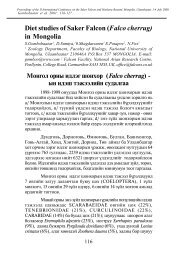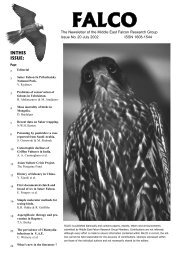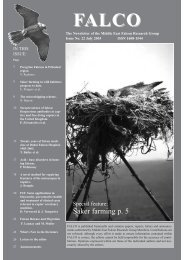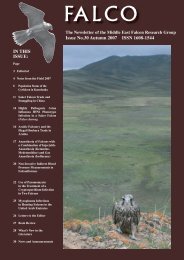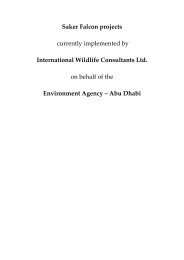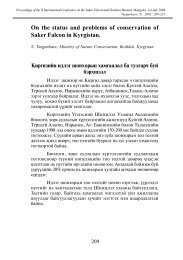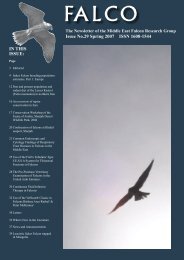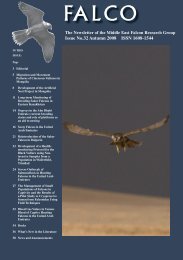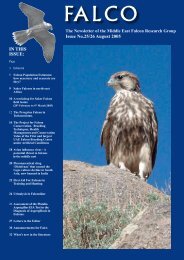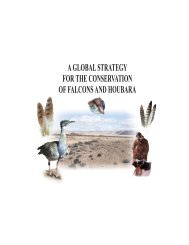Falco 27 - International Wildlife Consultants Ltd.
Falco 27 - International Wildlife Consultants Ltd.
Falco 27 - International Wildlife Consultants Ltd.
- No tags were found...
Create successful ePaper yourself
Turn your PDF publications into a flip-book with our unique Google optimized e-Paper software.
MEFRG Objectives:To provide:A central body for the co-ordination of research activitiesrelated to falcons and falconry.A common forum for the exchange of information and forpromoting collaborative research programmes.To promote:Research on health and disease in falcons, falcon moulting inthe Middle East, falcon nutrition, domestic breeding.Field studies on falcon migration, taxonomy, morphometrics,reproductive biology and behaviour.Improved management conditions for captive falconsthrough educational awareness programmes.Greater understanding of falconry as a part of Arab culturalheritage.FALCO onlinePrevious issues of FALCO as well as instructions forauthors can be downloaded from:http://www.falcons.co.uk/default.asp?id=131also see new Saker Conservation information portal:www.savethesaker.comTo hold:nd <strong>International</strong> workshops and conferences on veterinaryaspects, falcon biology topics, falconry and conservationissues.To publish:Papers on aspects of falcon conservation, falcons andfalconry.A biannual newsletter/journal containing contributions onmedical. biological and conservation topics of commoninterest, new developments and recent medical advances.Membership:Membership is open to any veterinary surgeon, biologist,conservationist or falconer working in the Middle East orany other person interested and contributing in the fields ofmedical, biological and conservation aspects of falcons andfalconry worldwide.<strong>Falco</strong> is published biannually and contains papers, reports, letters and announcements submitted by Middle East <strong>Falco</strong>n ResearchGroup Members. Contributions are not refereed: although every effort is made to ensure information contained withinFALCO is correct, the editors cannot be held responsible for the accuracy of contributions. Opinions expressed within are thoseof the individual authors and are not necessarily shared by the editors.Contributions can be sent to the Editors of FALCO:Dr Andrew Dixon and Dr Tom BaileyEditorial address:Veterinary contributions:Dr Andrew DixonDr Tom Bailey<strong>International</strong> <strong>Wildlife</strong> <strong>Consultants</strong> <strong>Ltd</strong>Dubai <strong>Falco</strong>n HospitalP.O. Box 19, Carmarthen P.O. Box 23919SA33 5YL, Wales, UKDubai, United Arab EmiratesTel: (0044) 1267 253742 Tel: 00971 4 3377576Fax: (0044) 1267 233864 Fax: 00971 4 3379223E-mail: falco@falcons.co.ukE-mail: tom.bailey@dfh.ae
EditorialAt the time ofgoing to press weheard the sad news of the passing away ofHis Highness Shaikh Maktoum Bin RashidAl Maktoum, Vice President and PrimeMinister of the UAE and Ruler of Dubai. Asa co-owner of Dubai’s Godolphin stables hewas best known internationally for his interest inhorse racing, but he was also a great friend of falconry in theregion.Avian influenza or bird flu is probably the biggest issueto affect falconry in the Middle East this season. TheEnvironment Agency of Abu Dhabi (formerly ERWDA) hascoordinated the ‘The National Committee for EmergencyResponse to Bird Flu’ and produced an Action Plan for theUnited Arab Emirates (http://www.ead.ae). These actions bythe UAE authorities are commendable, because within theMiddle East region some countries appear less prepared.In November, ProMED-mail, an internet based discussionprogram of the <strong>International</strong> Society for Infectious Diseases(http://www.isid.org), reported two cases of avian influenzacaused by the deadly H5 strain in unspecified wild birds inKuwait. However, these cases were regarded as “suspected”,because no further details or confirmation from a recognizedreference laboratory were made available to the Office<strong>International</strong> des Epizooties (OIE), the officially recognisedinternational organisation that reports notifiable veterinarydiseases (http://www.oie.int). In early December, ProMEDmailreported avian influenza in Libya, although theauthorities there contradicted local press reports and deniedthe disease had occurred. In December the H5N1 strain ofavian influenza was isolated in a saker falcon that died ina <strong>Falco</strong>n Hospital in Riyadh, Saudi Arabia (see the lettersto <strong>Falco</strong> section). Interestingly, despite confirmation of thestrain from a German reference laboratory the authorities inSaudi Arabia have not reported this case to the OIE. Thelack of transparency and openness in disease reporting in theregion is unlikely to be helpful in the control of this diseaseand should concern those tasked with keeping notifiablediseases out of the region.Movement restrictions on the importation of wild caughtbirds, including houbara bustards and falcons, have beenimplemented by regional governments. It might havebeen expected that this season, with wild bird imports“theoretically” banned, with well publicized bird flupublic information campaigns by the media, with the readyavailability of large numbers of high quality healthy captivebred falcons and with the ability to mass-produce houbarabustards in captivity for training, that the trade in wildbustards and wild falcons might have diminished. It has beendisappointing to hear reports that wild-caught birds were stillbeing bought into the region. As we go to press, Turkey hasjust confirmed the first human deaths caused by avian flu thathave occurred outside Asia. <strong>Falco</strong>ners and veterinarians mustwork together to keep this potentially devastating disease outof the region. Consequently, in this issue of <strong>Falco</strong> we havean article and two letters on avian flu and it can be seen thatthis is a topic that stimulates differences in opinion.In our editorial for the last issue of <strong>Falco</strong> we mentioned theReview of Significant Trade in Saker <strong>Falco</strong>ns that is beingundertaken by the CITES, and hopefully there will be somefurther news to report from the 22nd meeting of the CITESAnimals Committee in Peru in July 2006. This trade reviewprocess is concerned primarily with recommendations forgoverning a legal trade in Saker <strong>Falco</strong>ns, but it has beenrecognized for a long time that the trade in falcons forfalconry also involves considerable illicit trade. Concernsabout this illicit trade led to calls for the establishment ofa task force to examine law enforcement related issues.Consequently, the CITES <strong>Falco</strong>n Enforcement Task Forcewas established, comprising enforcement officials fromthose countries most affected by illicit trade in falcons. TheCITES <strong>Falco</strong>n Enforcement Task Force was charged withorganizing a meeting to establish a network of officials thatwould be responsible exchanging information to facilitatethe detection of illicit trade incidents. The UAE hosted thefirst meeting of the CITES <strong>Falco</strong>n Enforcement Task Forcein November 2005 (see News and Announcements section).Now CITES has two parallel processes running, the review oflegal trade of Saker <strong>Falco</strong>ns and the task force investigatingillicit trade in all falcons. Given that a major concern withthe current legal trade in wild caught Saker <strong>Falco</strong>ns is thelack of transparency in the process and the suspicion that itis open to abuse by corrupt government officials it will beinteresting to see if the remit of the new task force will alsocover this aspect of illicit trade.Thanks to a kind donation by Dr. Dan Brimm and Lisa Jerezwe are able to provide Arabic translations of articles andthe editorial as part of our commitment to expanding ourreadership. We extend our thanks to Dr. Monif Al Rashidifor his interesting contribution from Saudi Arabia, we needmore articles from our Arabic readers, and appeal to ourArabic colleagues, scientists, veterinarians or falconers,to contribute in future issues of <strong>Falco</strong>. This is your regionand your opinions matter. Saker <strong>Falco</strong>ns breeding in bothAsia and Europe can pass through or spend the winter inthe Middle East, consequently breeding populations ofthis species, wherever they occur in the world fall withinour sphere of interest. In this issue, Dimitar Ragyov andVesselina Shishkova report on the population trend of theSaker <strong>Falco</strong>n in Bulgaria over the last century. This studyforms part of a project to develop a network of researchersto get a better understanding of the status of the species insoutheast Europe and Turkey, a region with little detailedinformation on Saker <strong>Falco</strong>ns. We also wish to thank JevgeniShergalin (<strong>International</strong> <strong>Wildlife</strong> <strong>Consultants</strong> <strong>Ltd</strong>) foridentifying interesting material for inclusion in this issue.Editorial update on 29/1/6 at the time of going to pressAt the time of sending <strong>Falco</strong> to press regional newspapers inthe Middle East (Emirates Today, Sunday 29th 2006) reportedthat 37 falcons were culled in a <strong>Falco</strong>n Hospital in Riyadh,Saudi Arabia because of an outbreak of H5 influenza. Thefact that the Saudi authorities are now acting to deal with thisH5 outbreak is a step in the right direction, although manyquestions remain on why the response was delayed for solong.
The Saker <strong>Falco</strong>n in Bulgaria: Past, Present and FutureDimitar Ragyov & Vesselina ShishkovaAffiliation:Institute of Zoology , Bulgarian Academy of Science, Sofia1000 blv. Car Osvoboditel 1, Bulgaria.E-mail: ragyov@abv.bgSummaryWidespread and numerous in the past, the Saker <strong>Falco</strong>nin Bulgaria is presently on the edge of extinction. Thespecies’ population collapsed between 1930 and 1960under the influence of the following factors: habitatloss; decrease of European Souslik; pesticide andfertilizer use; poaching (shooting) and use of poisonbaits. Another factor presently having a strong negativeinfluence is nest robbery.In 2006 the Bulgarian Academy of Science (BAS)and <strong>International</strong> <strong>Wildlife</strong> <strong>Consultants</strong> <strong>Ltd</strong>. (IWC <strong>Ltd</strong>)with the financial contribution of the EnvironmentalAgency of Abu Dhabi (EAD) will initiate a researchand conservation project “Saker <strong>Falco</strong>n in Bulgaria andSoutheast Europe”. The main objective of the project isto stop the decline in Saker population in the region.IntroductionGeographically Bulgaria is close to the westernmostlimit of the Saker <strong>Falco</strong>n (<strong>Falco</strong> cherrug) distributionrange. Located on the Balkan Peninsula in SE Europe,the country has a varied relief and a wide range ofhabitats, including steppe, old natural forests, rockymassifs and high mountain meadows (over 2500 m).The lowest part of the country is the Black Sea coastand the highest point is “Musala” peak at an altitudeof 2925 m.The distribution ranges of Saker, Lanner (<strong>Falco</strong>biarmicus) and Peregrine <strong>Falco</strong>ns (<strong>Falco</strong> peregrinus)overlap in Bulgaria. The Gyrfalcon (<strong>Falco</strong> rusticolus)was a very rare, accidental winter visitor in the past,whilst Barbary <strong>Falco</strong>n (<strong>Falco</strong> pelegrinoides) ismentioned in the literature as “probable” species in thecountry (Nankinov, 1992) but there is no certain recordavailable. All the large falcons within the territory ofBulgaria are rare species with serious threats to thesurvival of their populations.Past statusSaker <strong>Falco</strong>n population decline in BulgariaNumerous and widespread in the past, the Saker <strong>Falco</strong>nis presently on the edge of extinction in Bulgaria. Atthe end of 19 th Century and the beginning of the 20 thCentury, according to different authors the Saker isdescribed as: “very common species. More than fivenests found in a few days only” (Elwes & Buckley1870 in Michev & Petrov, 1985); “frequently seen inthe forests of Dobrudja” (Sintenis, 1877 in Michev &Petrov, 1985); “besides Black Kite and Marsh Harrier,the Saker is the most widespread bird of prey species inDobrudza and is abundant around the Danube marshesand hill forests” (Floericke, 1918); “common breederaround Danube river” (Patev, 1950). Based on thesestatements, we consider that at the beginning of the 20 thCentury at least 2000 pairs of Saker <strong>Falco</strong>ns inhabitedthe Bulgarian territory.Nowadays estimates of Saker <strong>Falco</strong>n numbers are:2–6 pairs (Burfield & van Bommel, 2004), 4-10 pairs(Birds Of Prey Protection Society, 2005) and 8-12pairs (Nankinov et al., 2004)Many of the causal factors for the population decline aresimilar to those operating elsewhere in the world rangeof the Saker <strong>Falco</strong>n, but some factors are specific toBulgaria. There are two important events in Bulgaria’scontemporary history, World War II and the changeof regime in 1989. These events not only affectedthe political situation but also drastically changed theeconomy of the country, the lifestyle of the people andinevitably had a significant influence on wildlife aswell.Agricultural practices were altered after World War IIin that pastoralism declined rapidly and ‘high farming’started. The existing Saker hunting habitats (i.e.,wide open spaces with low grass cover) were eitherleft uncultivated so that the wild grasses grew tall,reducing the availability of ground dwelling prey forSakers, or they were replaced by massive agriculturalmonocultures. Intensive agriculture is associatedwith the mass extermination of rodents, includingSousliks (Spermophilus citellus), an important preyspecies for Saker <strong>Falco</strong>ns. Pesticides and fertilizerswere extensively used in intensive agricultural systemsduring the decade 1970-80. Their effect on wildlifewas significant and numerous wild animals were founddead after these chemicals were applied using aircraft.The widespread use of poison baits against predatoryanimals (mainly strychnine) took place between1930-70, and during this period the terms “harmfulmammals” and “harmful birds” came into fashion.Almost all birds of prey, crows and predatory mammalswere considered harmful for the “socialist people’sagriculture” and therefore they were poisoned or shotat every opportunity. There has even been a furtherincrease in the shooting of birds of prey since 1980 ashunters in Bulgaria had a legal duty to kill birds of prey.As a result of these factors, sometime in the period 1930-60 the Saker <strong>Falco</strong>n population in Bulgaria collapsed.
Negative Factor 1930’s 1940’s 1950’s 1960’s 1970’s 1980’s 1990’sPesticides and fertilisersYesShooting Yes Yes Yes Yes YesHabitat loss Yes Yes Yes Yes YesDecline of Sousliks Yes Yes Yes Yes YesPoison baits Yes Yes Yes Yes YesNest robbery and trapping Yes YesTable 1. The timing of negative influences affecting Saker <strong>Falco</strong>ns in Bulgaria during seven decades from the 1930’s to the1990’s. The table shows the period with the most intensive influence of each negative factor.Unfortunately, there is no published data to gauge thesignificance of the different causal factors individuallyor to quantify the extent of the decline at different timesover this 30-year period.The change in the ruling regime in 1989 resulted in theopening of Bulgaria’s borders and an increase in allaspects of international trade, including the legal andillicit trade in falcons. Even though some trapping andnest robbery existed before the change in regime, whereit is reported that approximately ten groups of falconpoachers operated on the Balkan Peninsula (Scheglman,1983 in Michev & Petrov, 1985), nest robbery (of botheggs and chicks) and trapping have further increasedsince 1989. It is believed that illegal trapping hasdisrupted the sex ratio of the small remaining Saker<strong>Falco</strong>n population in Bulgaria, either because femalesare more easily caught or because trappers prefer them,with more males than females reported in the formerbreeding ranges.Date Estimate (bp) Source
• Inclusion of some Saker <strong>Falco</strong>n breeding sites intoa network of protected areas such as Nature Parks,Nature Reserves, Important Bird Areas (IBA’s) andthe Natura 2000 network of sites.• Activities undertaken by BPPS, BSPB, the policeand Ministry of Environment and Water (MoEW)targeted at preventing nest robbery and trapping.• The current Hunting Law in Bulgaria forbidshunting with Saker <strong>Falco</strong>ns and other birds of prey.Despite of the presence of these national laws and theimplementation of the specific actions detailed above,the population decline has not been reversed and thecurrently the population is close to extinction in thecountry.Ecology of the Saker <strong>Falco</strong>n in BulgariaThe ecology of the species in Bulgaria is not studiedwell and to date no specific ecological study has beenundertaken in the country. Data on the species hasobtained incidentally through other projects and fieldactivities; consequently the available data is scarce andnon-systematic.Figure 2. Saker <strong>Falco</strong>n distribution range in Bulgaria(reproduced from Stoyanov & Kouzmanov 1998). Thebreeding sites are shown in 25x25 km squares. Large dots= Proven breeding, medium dots = Probable breeding andsmall dots = Possible breeding.Breeding distributionIn the past the Saker <strong>Falco</strong>n was regarded as awidespread and very common species over the entireBulgarian territory (especially the northern regionsand the plains around Danube River). In more recenttimes (15-20 years ago) it was still widespread but withdiminished numbers. Nowadays it has a fragmenteddistribution range and has already disappeared frommost of its traditional breeding sites (Domuschiev et al.2005). Stoyanov and Kouzmanov (1998) have preparedthe most recent and complete map of the Saker <strong>Falco</strong>ndistribution range in Bulgaria (reproduced in Figure 2).It must be noted that this map presents the historicaldistribution of the Saker <strong>Falco</strong>n since the early 20 thCentury and has been compiled from published datasince 1918, and not simply from the recent publisheddata of Bulgarian ornithologists and the personal dataof the authors. Consequently, some of the breedingareas shown on this map were no longer extant whenit was compiled in 1998. The breeding distributionof the Saker <strong>Falco</strong>n in Bulgaria is thought by manyresearchers to be closely related to the distribution ofits main prey, the European Souslik.Altitudinal distributionIn the past the species was more numerous in the lowerpart of the country (within the altitudinal range 0 to 500m). Unfortunately this also is the region with greatesthuman presence and anthropogenic pressure. Saker<strong>Falco</strong>ns have largely disappeared from these regionsand most of the recent breeding records relate to highmountains or inaccessible rocky places with low levelsof human disturbance (Figures 3 and 4).Habitat selectionSaker <strong>Falco</strong>ns nest in trees or on rocks close to twomain types habitat in Bulgaria: (i) wetlands such asrivers, bogs, marshes, swamps, fens, peat lands and(ii) open areas such as grasslands or agricultural fields.Michev and Petrov (1985) found 13 Saker nests, nine(69%) of which were on rocks and four (31%) were intrees. Stoyanov and Kouzmanov (1998) found 15 nests,11 (73%) of which were on rocks and four (<strong>27</strong>%) werein trees. According to them nesting on electric pylons ispossible recently. Outside the breeding season, all typesof habitats are used during migration and wintering.DietThe European Souslik is the main prey species takenby Saker <strong>Falco</strong>ns during the nestling period of thebreeding cycle. Nevertheless, Saker <strong>Falco</strong>ns alsofeed on other small mammals (rodents) and small tomedium sized birds such as pigeons, crows and smallpasserines. However, a detailed study on the diet of theSaker <strong>Falco</strong>n has never been conducted in Bulgaria.Breeding biologyThe Saker <strong>Falco</strong>n occupies its breeding territory at theend of February and beginning of March (Domuschievet al. 2005). For regions lower than 1000 m abovesea level it lays eggs in the middle of March and thechicks fledge from the nest at the end of June. Ataltitudes above 1000 m, Saker <strong>Falco</strong>ns lay their eggsat end of March and the chicks fledge in late Juneor early July (Stoyanov & Kouzmanov, 1998). Thetypical incubation period is ca. 30 days, with clutchsizes ranging from 2-6 eggs (normally 3-5). The chicksleave the nest after ca. 40-45 days (Domuschiev etal., 2005). The breeding success of Bulgarian pairsis very low; usually eggs are laid and incubation isobserved but later the nest is abandoned although theadult birds remain in the area. In majority of the casesthe failure is caused by human intervention (Stoyanov
Figure 3. Typicalupland breeding siteof the Saker <strong>Falco</strong>nin the Stara Planinarange in centralBulgaria& Kouzmanov, 1998). The last recorded breedingsuccesses were in 1997 when a pair fledged two chicks(Stoyanov, 2001), in 2003 when a juvenile was seenon the 12 th June and in 2005 when a pair with fledgeda single chick (Domuschiev et al., 2005). Breedingfailure can also result from natural causes such as thedestruction of nests by intensive rains and rock falls inspring, or from sudden low temperatures and snowfallsin period March-May. Adverse weather conditions canaffect Souslik populations as well, resulting in reducedfood availability and subsequent nest failure (Stoyanov& Kouzmanov 1998).Figure 4. Vertical distribution of Saker <strong>Falco</strong>n nest sitesin Bulgaria: data from Michev & Petrov (1985; bluecolumns, N = 32 nests) and Stoyanov & Kouzmanov(1998; purple columns, N = 15 nests)MigrationSaker <strong>Falco</strong>ns are regular visitors to Bulgaria during thepost-breeding migration period (August to October),and can be encountered across the entire country butespecially along the Black Sea coast and its largewetlands with concentrations of waterbirds. Probablymost of the Sakers observed in Bulgaria during the latesummer and autumn period are juveniles from Ukraine,Moldova and Hungary. It is not known for certain ifBulgarian birds (adults and/or juveniles) migrate in theautumn and, if they do, where they go. Certainly, Saker<strong>Falco</strong>ns are very rare in Bulgaria in the winter periodfrom January to February. According to Stoyanov& Kouzmanov (1998), depending on the prevailingweather conditions many pairs stay in the area oftheir breeding sites (even at altitudes up to 1500 m)during the winter period from November to February.At high altitudes above 1500 m pairs tend to leavetheir breeding ranges, possibly moving to lower lyingplains or visiting places with concentrations of birdson a regular basis. What this most likely signifies isthat some of the Bulgarian breeding birds are residentand others are migratory, though the extent of thesemigratory movements is not known.Relationship between Saker <strong>Falco</strong>ns and other birdsIn Bulgaria Saker <strong>Falco</strong>ns preferentially nest in theexisting nests of other bird species, though in very rareinstances the clutch is laid on a bare rock ledge. Hostspecies for nests located in trees are: Hooded Crow(Corvus cornix), Common Buzzard (Buteo buteo),Goshawk (Accipiter gentilis) and herons. Host speciesfor nests located on rocks are Raven (Corvus corax)
and other raptors, typically Long-legged Buzzard(Buteo rufinus) and Golden Eagle (Aquila chrysaetus)(Stoyanov & Kouzmanov, 1998: Domuschiev et al.,2005; Michev & Petrov, 1985)FuturePresently the Bulgarian Academy of Science togetherwith <strong>International</strong> <strong>Wildlife</strong> <strong>Consultants</strong> <strong>Ltd</strong>., on behalfof the Environment Agency of Abu Dhabi (AED) isestablishing a research and conservation programme onthe Saker <strong>Falco</strong>n in Bulgaria, with a view to developinga network of studies across southeast Europe andTurkey. The main objective for the project is to identifythe main causal factors in the demise of the Saker <strong>Falco</strong>npopulation in the region and to implement managementprocedures to halt and reverse this process. Specificobjectives for 2006 are:• Collecting and analysing breeding and ecologicalinformation on the species• Developing measures for Saker <strong>Falco</strong>nconservation and management in Bulgaria• Improving breeding success of the existing pairs ofSaker <strong>Falco</strong>ns in Bulgaria• The creation of a network of teams andpartnerships between organizations to work onSaker <strong>Falco</strong>n conservation projects in southeastEurope and TurkeyThe project will include workshops for discussionabout Saker <strong>Falco</strong>n conservation problems in theregion. Organizations from Bulgaria and othercountries of southeast Europe will take part in thesemeetings in order to develop an inter-country networkof researchers across the region. Fieldwork in Bulgariaduring 2006 will involve systematic surveys for Saker<strong>Falco</strong>n nesting sites in order to get a better estimateof population size as well as nest site monitoring andguarding of nests (including the use of video cameras)in order to preserve the nest from robbery and tocollect biological data from the breeding period. Todate a national Saker <strong>Falco</strong>n project has never beenimplemented in Bulgaria.We intend to start better coordination in Saker <strong>Falco</strong>nconservation and management work by supportingthe establishment of a trained research team. Betterknowledge on the breeding ecology and populationthreats facing Saker <strong>Falco</strong>ns in Bulgaria is expected bythe end of the year. We hope to expand our researchand conservation actions in the adjacent countries inthe course of next years with the help of local partnerorganizations.sources are the ones by Georgi Stoyanov, DobromirDomuschiev, Dr. Tanju Michev and Dr. Ceno Petrov.We want to express our sincere gratitude for theirexperience and knowledge.ReferencesBirds of Prey Protection Society. 2005 <strong>International</strong>Single Species Action Plan - Workshop for theConservation of the Saker <strong>Falco</strong>n in its EuropeanRange, Csakvar, Hungary, 11-13 February 2005Burfield, I. and van Bommel, F. 2004. Birds inEurope. The BirdLife <strong>International</strong> EuropeanPartnership, Pp.89. Birdlife.Domuschiev, D., Stoyanov, G., Michev, T., Petrov,C., Vatev, I. and Ruskov, K. In press. New Red DataBook of Republic Bulgaria (in Bulgarian)Floericke, K. 1918. Forscherfahrt in Feindesland,Zweiter Teil: Ornitholgisch-wissenschaftlicheErgebnisse. Stuttgart, Kosmos. (in German).Kostadinova, I. 1997. Important Bird Areas inBulgaria. BSPB Conservation Series. Book 1.BSPB, Sofia.Michev, T. and Petrov, C. 1985. Red Data Book ofBulgaria. Vol. 2. Animals. (in Bulgarian)Michev, T. and Petrov, C. 1985, Distribution andpopulation size of Saker <strong>Falco</strong>n in Bulgaria.Blagoevgrad 23-28 IX 1985. <strong>International</strong> symposium“Conservation of nature territories and the genetic fundcontained in them” Reports Vol.1 National committeeof Bulgaria of “Man and Biosphere” program, Sofia,BAS, 1985. Pp.314-323 (in Bulgarian)Nankinov, D. 1992 Check list of bird species andsubspecies in Bulgaria. Avocetta N 16:1-17 (1992)Nankinov, D., A. Dutsov, B. Nikolov, B. Borisov,G. Stoyanov, G. Gradev, D. Georgiev, D. Popov,D. Domuschiev, D. Kirov, E. Tilova, I. Nikolov, I.Ivanov, K. Dilchev, K. Popov, N. Karaivanov, N.Todorov, P. Shurulinkov, R. Stanchev, R. Aleksov,R. Tsonev, S. Dalakchieva, S. Ivanov, S. Marin, S.Stajkov, S. Nikolov, H. Nilkolov. 2004. Number ofnational populations of birds breeding in Bulgaria.Green Balkans. Plovdiv, 2004. (in Bulgarian)Patev, P. 1950. Birds in Bulgaria. Bulgarian Academyof Science, Sofia. (in Bulgarian)Simeonov, S., Michev, T and Nankinov, D. 1990,Fauna Bulgarica 20: Aves. Part I, pp. 218-220. (inBulgarian)Stoyanov, G. 2001. The birds of Ponor Mountain.Forestry Ideas 1-4 (25). pp.100-125 (in Bulgarian)Stoyanov, G. and Kouzmanov, G. 1998. Nuevos datossobre la Poblacion del Halcon Sacre <strong>Falco</strong> cherrug enBulgaria. In Holarctic Birds of Prey. Proc. of an Int.Conf. Badajoz. WWGBP. pp.357-362. (in Spanish)AcknowledgementsThe data about Saker ecology in Bulgaria is obtained bypublication research. The most important and valuable
An Ecological Study on Hunting <strong>Falco</strong>n Species and theirProtection in Saudi ArabiaMonif M. Z. AlrashidiLecturer, Science Department, Teachers College, Hail City,Saudi Arabia. E-mail: mm_alrashedi@yahoo.comSummary<strong>Falco</strong>nry is a widespread sport and hobby within SaudiArabia. Four species of falcons are used for hunting inSaudi Arabia: Saker <strong>Falco</strong>n (<strong>Falco</strong> cherrug), Peregrine<strong>Falco</strong>n (<strong>Falco</strong> peregrinus), Lanner <strong>Falco</strong>n (<strong>Falco</strong>biarmicus) and Barbary <strong>Falco</strong>n (<strong>Falco</strong> pelegrinoides).This study was conducted from October 2001 untilDecember 2003. Field surveys and questionnaireswere used to (i) identify the geographical distributionof the four hunting falcon species in Saudi Arabia,(ii) to define their natural habitats, (iii) the timing oftheir breeding, migration and moulting seasons. I alsopropose methods for the protection of these importantspecies in Saudi Arabia.IntroductionFour falcon species are used for hunting in SaudiArabia: Saker <strong>Falco</strong>n (<strong>Falco</strong> cherrug), Peregrine <strong>Falco</strong>n(<strong>Falco</strong> peregrinus), Lanner <strong>Falco</strong>n (<strong>Falco</strong> biarmicus)and Barbary <strong>Falco</strong>n (<strong>Falco</strong> pelegrinoides). <strong>Falco</strong>nryis one of the most common known traditions for thepeople of Arabian Peninsula. It has been known for itsimportance to nomads (Bedouins) because it providedfood for them. Different people – high or even lowerranks - used falcons for different purposes such as ahunting sport, luxury or as a lovely hobby.Although falconry is a lovely hobby, a falconer needs tohave some characteristics for doing such a job such asa sufficient experience and money. The cost of moneycan vary from one falcon to another according to theexternal appearance and its ability to hunt .The Saker<strong>Falco</strong>n is considered as the best one. The Peregrine<strong>Falco</strong>n comes in the second rank, then follows Lanner<strong>Falco</strong>n and Barbary <strong>Falco</strong>n.MethodsThis study was conducted from October 2001 until December2003 and resulted in a thesis submitted in partial fulfilmentof the requirements for an MSc degree at the Department ofBiological Sciences, Faculty of Science, King Abdul-AzizUniversity, Jeddah.I studied the breeding behaviour of a pair of Barbary<strong>Falco</strong>ns nesting in the Jabal Al-Khitam, MadinahDistrict.I recorded the weight (g), wing length (mm), tail length(mm) and tarsus length (mm) for captive specimensof the four falcon species studied. I did not separateFigure 1.biometric data between sexes in order to avoid makingany wrong allocation of sex because I did not have moresufficient information to distinguish between male andfemale.Data on the timing of moult was obtained from recordsof captive birds only, with exception of the Barbary<strong>Falco</strong>n, which was studied both in the wild and incaptivity.Questionnaires were sent to falconers requestinginformation on:- Why do you use falconry? How longhave you been using falconry? How many falcons doyou have? What is the longest period of time you kepta falcon? How many falcons did you hunt by yourself?Do you agree or disagree on the following: one of thereasons of decreasing the number falcons is keeping afalcon for a long time, the high cost of falcons and theincreasing number of hunters of falcons.ResultsDistribution of falcon species in Saudi Arabia:The two migratory species covered in this study,namely Peregrine <strong>Falco</strong>n and Saker <strong>Falco</strong>n, occurredduring autumn migration in many habitats whenevertheir favoured prey was available. However, theirdistribution is concentrated along the Red Sea coast inthe west of the country. Their autumn migration seasonstarted from September and lasted until December, withthe peak period of migration taking place in October.Adult Peregrine <strong>Falco</strong>ns arrived earlier than immaturebirds, whilst for Saker <strong>Falco</strong>ns the reverse was true andimmature birds reached Saudi Arabia before adults.
of wild falcons. Such changes would be facilitatedby better organisation of the sport of falconry andnew laws relating to hunting with falcons. <strong>Falco</strong>nersshould be encouraged to take part in organised falconreleasing programs, and to release their wild-caughtfalcons after the end of the hunting season as wastraditionally practiced. In this respect, there should belaws defining the period when wild-caught falcons canbe kept in captivity.Figure 2. Jabal Al-Khitam, Madinah Districtof falconry sport and the other is to make money byselling falcons. The respondents to the questionnairesfelt that the current decrease in the number of wildfalcons in Saudi Arabia might be caused by severalfactors. Respondents indicated that there are too many“falcon trappers”, which are driven by the high valueof falcons, whilst others felt the decline might be aresult of people keeping falcons in captivity for longperiods, rather than releasing them after the huntingseason as was traditionally practiced. <strong>Falco</strong>ners andtrappers had some positive ideas as to measures thatcould be implemented to halt the continued decline inthe number of falcons in Arabia, which included theintroduction of identification cards for falcons andfalconers, defining the period of keeping falcons incaptivity, defining the value of hunting falcon in SaudiRiyals, the establishment of centres for captive breedingof falcons and clubs for falconers.DiscussionConservation and protection methods:The problem of the declining falcon population inSaudi Arabia can be resolved by cooperation betweenpeople in the falconry business and the government, inorder to produce a joint plan to address this problem.Recommendations include, increasing public awarenessof the problem, particularly with those who possessfalcons, and to introduce the importance of falconry topublic via magazines and television media. It wouldbe beneficial if the monetary value of hunting falconswere defined.Increasing the numbers of captive-bred hunting falconsavailable might reduce the demand for wild falcons.This could be achieved though the establishment offalcon breeding centres specifically producing birdsfor the falconry market. In conjunction laws couldbe passed either preventing or regulating the captureAs well as protection of the falcons, it is also vital thatany conservation programme includes some form ofprotection for the traditional falconry quarry species.This could be done by establishing protected areasto increasing the numbers of important species suchas Houbara Bustard Chlamydotis macqueenii, StoneCurlew Burhinus oedicnemus and Arabian Hare Lepusarabicus.Figure 3. Barbary <strong>Falco</strong>n nestling with two unhatched eggsAcknowledgementsFirst of all, all praise is to Allah my God for that help Hegave me to finish this dissertation. I would like to takethis opportunity to thank all those who contributed to myresearch by any means, help, advice, recommendationsand so on. I would like to thank my MA supervisor Dr.Hassan Mahfooz Felimban for every single effort hemade and for his help, recommendations and very nicefeedbacks. Without his help, I would not do such a nicea research. I would like to extend my best greetings andthanks to all falconers who helped me in my research; Abed Marzook Al rashidi , Moateq Thowaiher Alrashidi , Thari Marzook Al rashidi and Mosaad Althaalobi. Thanks are also extended to my colleagues;Mr.Aboamr Al ghamdi , Mr. Soliman Abdullah Alroman, Mr. Youssef Maqboul Al rashidi , Mr. SalemMoateaq Al rashidi and Mr. Youssef D. Al asmary. Forall the above mentioned and many others, I want to saywithout your help I would have suffered greatly.11
Amyloidosis – An Emerging Disease in Hunting<strong>Falco</strong>ns in the Middle EastJoerg Kinne & Ulrich WerneryAffiliation:Central Veterinary Research Laboratory, Dubai, United ArabEmirates. jkinne@cvrl.co.aeSummarySince amyloidosis is an increasing problem inhunting falcons in the UAE a retrospective study wasperformed on 266 liver biopsies and samples from 961falcon necropsies carried out at the CVRL over the lastdecade. Amyloidosis was confirmed in 213 (22.2 %)of the 961 necropsied falcons. Thirty six percent ofthese cases were Gyr falcons, 29 % were Gyr hybrids,21 % were Peregrine falcons, 9 % were Saker falconsand 5 % were other or unknown species. Nearly threequarters of all amyloid cases were observed in the last5 years. The liver was the most affected organ withamyloid deposits in 86.4% of the cases. Amyloid wasfound also in kidney (61 %), spleen (42 %), pancreas(7%) and adrenal glands (11.7%). Renal medullaryamyloidosis was observed in 77 cases associated withvisceral gout. Amyloid was confirmed in 32.3 % of theliver biopsies.IntroductionAmyloidosis is an increasing problem not only inhumans (Linke, 1984;1985), but also in zoologicalspecies (Zschiesche and Linke, 1986; 1989; Shaw etal., 1987; Zschiesche and Jakob, 1989; Landmann etal.,1996), and in hunting falcons in the UAE (McKinney,2002; Hampel 2004). Therefore, a retrospective studywas performed on 266 liver biopsies and 961 falconnecropsies carried out at the CVRL over the lastdecade.methods. When amyloidosis was suspected organswere stained with H & E and with Congo red. Liverbiopsies, collected from 266 sick falcons since 2002,were also included in this study.Statistical analyses were performed using commercialsoftware (SPPS). The animals were grouped accordingto species, and the paired T-test was used to comparespecies distribution and amyloid incidence, as well asamyloid-incidence in necropsies and biopsies. The Chisquared-testwas used to compare species distributionand amyloid incidence before and after the year 2000.ResultsOf the total number of falcons included in the study,213 (22.2%) were Gyr falcons, <strong>27</strong>6 (28.7%) were Gyrhybrids,241 (25.1%) were Peregrines, 155 (16.1%)were Sakers and 76 (7.9%) were of other (Kestrel,Barbary and Lanner falcon) or unknown species (Figure1). Statistical analyses demonstrated that Gyr falconsand Gyr-hybrids were significantly (Chi-squared-test,p
Figure 7.Figure 8.Figure 9.Figure 10.Figure 11.Figure 12.18
Letters:The use of avian influenza vaccines in falconsDear Colleagues,There has been considerable interest in the use ofavian influenza vaccines in falcons in the UnitedArab Emirates. Many veterinary centres are using theIntervet H5N2 vaccine on captive falcons. There isnow a proposal to use a ‘Chinese H5N1 vaccine’ infalcons in the United Arab Emirates. The use of avianinfluenza vaccines in falcons raises a number of issues.I feel it is important to highlight specific concerns tostimulate debate, with the aim of reaching a consensusamong clinicians involved in the UAE falconry scene.Questions:n Has the vaccine any side effects when used in falcons,for example does it reduce flying performance ordoes it stimulate amyloidogenesis in gyr hybrids?n The H5N2 vaccine has been used on valuable birdsof a variety of species. Not all species respond tothe vaccine. Do falcons respond to vaccination?Does the H5N2 vaccine offer effective protectionagainst H5N1 or does it induce partial protectionallowing amplification of the virus?n Only a few cases of H5N1 have been documentedin raptors, are they naturally resistant to clinicaldisease? Avian influenza (H5N1) is importantbecause it affects humans. Eradication of the diseaseis preferable if possible. <strong>Falco</strong>ns are expensive, butI am confident that the Shaikhs buying the falconsconsider their people more important than the falconsand would cull infected falcons. If falcons cost thesame as chickens would they be vaccinated?n Would it be prudent to conduct a serological surveyon falcons to assess previous exposure to H5N1?n Reference laboratories should be able to differentiateantibody titres between vaccinated falcons and thosethat have been naturally exposed to the virus. Canthis testing be performed routinely in the UnitedArab Emirates? The current blood screening testsused at UAE Ministry of Animal Wealth quarantinefacilities cannot do this, which calls into questionthe efficacy of quarantine facilities for falcons.Until laboratories in the Middle East are equippedto differentiate between falcons that have beenexposed to infection, as opposed to falcons thathave been vaccinated, the international movementof falcons is compromised.My view is that because H5N1 has not been detectedin UAE there is no need for widespread vaccinationof falcons. I would support a vaccination trial on acontrolled, isolated, experimental group of falcons,which would provide information on the efficacy andsafety aspects of vaccination.The use of unlicensed avian influenza vaccines mayhave legal and international implications. I would urgeclinicians to obtain permission from the governmentveterinary authorities, before these vaccines are used.I trust this letter stimulates discussion on the topicand also helps clinicians develop an agreed protocoltowards Avian Influenza vaccination in falcons in theEmirates.PeterMcKinney. MBV MRCVS CertZooMedAustralian Raptor Conservation TrustEditors note:There are many different opinions on the issue of vaccinationof falcons against avian influenza. We hope to report someof the serology results from vaccinated falcons in the nextissue of <strong>Falco</strong>.Avian influenza in Saudi falconsDear Sir,I am writing to inform you that we had the first confirmedcase of avian influenza subtype H5N1 in Saudi Arabia.This was a Saker <strong>Falco</strong>n (<strong>Falco</strong> cherrug) that had beenin the country for the past 2 years. The bird arrivedfor a general check up with a history of anorexia oftwo days and passing green faecal. We conducteda complete check up on the bird including physicalexamination, endoscopy of the upper GIT, radiographsand haematology. The bird was diagnosed undergoingan acute viral infection (Newcastle disease was assumedat the time) as suggested by the haematology results,clinical signs and medical history.The falcon was placed in an isolation room, but diedovernight. The following day the falcon underwent afull post-mortem examination. Tissues were collected,both fresh and frozen. Samples were sent to the CVRLin Dubai for virus isolation. A few days later it wasconfirmed that the falcon had died of avian influenzaand samples were sent to the national avian influenzareference laboratory in Germany for further testing.The sample tested positive for H5N1.The case has been reported to the Saudi authorities whoare responsible for reporting notifiable diseases to theOffice <strong>International</strong> des Epizooties and World HealthOrganisation.I advise my colleagues working in falcon hospitals inthe region to be very vigilant and to implement strictbiosecurity programmes at their premises, particularlywith any wild caught birds coming from influenza‘hotspots’.Dr Jaime Samour21
News and AnnouncementsMinistry bans treatment of illegallyimported falcons(15/11/2005, The Emirates News Agency, WAM)Saeed Mohammed Al Raqbani, Minister of Agricultureand Fisheries issued a decision here (UAE) yesterdaybanning the treatment illegally imported falconsat veterinary clinics in the country. “With effectfrom today, falcons whose owners will not providedocuments proving legal entry of their falcons into thecountry will not be treated at Veterinary clinics”, saidthe decision. Clinics or vets who will not abide by thedecision will face legal action, the decision added. Themove is a precautionary measure to ward off the threatof bird flu.The main objective of the meeting was to discus illicittrade in falcons by identifying the main problems incontrolling the trade in falcons for falconry by studyingseizures that have been made in member countriesterritories since 2000 in order to identify smugglingmethods, routes, means of transport, characteristics ofthe illicit trade and, if possible, the identities of thoseinvolved. The meeting also prepared relevant guidanceto assist Parties in combating illicit trade. The analysisof the information will also be shared with ICPO-Interpol and the World Customs Organization.Aside from an analysis of the information,participants had been encouraged after the meeting totake note of illicit trade affecting their territories andto commit to making follow-up investigations, whereappropriate. In the meeting, participants established anetwork of contacts among task force members for therapid exchange of information regarding future seizuresof illicitly-traded falcons and for the coordination ofinvestigations. They also agreed undertake to act aslinks between the Task Force and other Parties and non-Parties affected by illicit trade in falcons, since it willnot be possible to invite all such States to the meeting.Participants consequently, agreed upon some form ofgeographical or sub-regional representation to providecoverage for networking.The meeting was attended by the CITES ManagementAuthorities or other competent authorities of Canada,China, India, Kuwait, Qatar, Kazakhstan, Kyrgyzstan,Mongolia, the Russian Federation and the UnitedKingdom. The first day of the meeting inauguratedby H.E. Majid Al Mansouri, Secretary General ,Environment Agency - Abu Dhabi followed by remarkspresented by Jonathan G. Barzdo, Chief, ConventionSupport Unit, CITES Secretariat. Mr. John M.Sellar, Anti-smuggling, Fraud and Organized Crime,CITES Secretariat, spoke on “The history of CITESEnforcement Task Forces and a description of the aimsof the <strong>Falco</strong>n Enforcement Task Force”, in additionthe CITES authorities of the United Arab Emirateswill present an “Introduction to the history of falconryand current trade in falcons for falconry”, includingan explanation of the falcon ‘passport’ scheme. Theillegal trade in wildlife, with an emphasis on falcons,will be also highlighted by the CITES Secretariat.UAE hosting CITES <strong>Falco</strong>n Enforcement TaskForceInformation from http://www.uaefalconer.comThe United Arab Emirates hosted the CITES(Convention on <strong>International</strong> Trade in EndangeredSpecies of Wild Fauna and Flora) <strong>Falco</strong>n EnforcementTask Force which been held in Al Raha Beach Hotel inAbu Dhabi from 21st to 23rd November 2005.22Country reports, providing details of illegal tradein falcons and seizure information since 2000were presented in the second day; this included Canada,China, Kazakhstan, Kyrgyzstan, Mongolia, RussianFederation, United Arab Emirates and United Kingdomof Great Britain and Northern Ireland. These country’sreports, reviewed in the afternoon sessions, to identifyillegal harvest methods, smuggling routes, smugglingtechniques (forms of transport, concealment techniques,types of couriers, etc. modus operandi associated with
dealers, places associated with dealers, transactions, etc.,final destinations and markets, prices paid (poacher tofinal consumer) and individuals known to be involved.On Wednesday, participants collated information fromprevious days and prepare summaries of each of theeight subject areas. They will also discuss how thisinformation can best be disseminated and used to aidnational law enforcement, target those involved, combatillegal harvest of falcons, increase border controls andcombat smuggling, combat illegal trade (in countries oforigin, transit and destination) Draft relevant Alert orother bulletin prepared where distribution and recipientswill be agreed. They will also discuss whether there ispotential to conduct immediate follow-up on any of theseizures or cases and decide how this can be achieved,in addition they will review draft identification materialprepared by Canadian <strong>Wildlife</strong> Service.Strategy for future exchanges of information,cooperation and coordination of investigations alsodisused and focal points for countries/agencies and bestmeans of communication will be agreed. They will alsodecide upon role of other relevant organizations andnon-governmental organizations. Finally, participantsalso identified any further actions that require to betaken to improve implementation of the Conventionregarding the trade in falcons for falconry and ineliminating illicit trade in these speciesAvian influenza in falcons: Saudi ArabiaInformation from a ProMED-mail posthttp://www.promedmail.org.ProMED-mail is a program of the <strong>International</strong> Society forInfectious Diseases http://www.isid.org.This information provides the background to thedecision of the Saudi authorities to carry out tests inthe involved falcon centre in Riyadh and, subsequentto obtaining several positive H5 results, to cull (all?)37 falcons therein.These unofficial but reliable data should be brought tothe attention of all those involved in the maintenance,handling and healthcare of falcons and other captive birdsin the Middle East and elsewhere. Hopefully, it will helpin enhancing the alertness of authorities responsible forcontrol upon international trade in avian species, withspecial attention to captive birds. Earlier H5N1incidents related to such trade have been recorded inTaiwan, Belgium, the UK and probably elsewhere.Saker <strong>Falco</strong>n in Southeast Europe: Researchand Conservation.A workshop meeting in Sofia, Bulgaria from <strong>27</strong>th to28th February 2006.A workshop meeting hosted by the Central Laboratoryof General Ecology, Bulgarian Academy of Scienceswas attended by delegates from several countries insoutheast Europe (including Croatia, Macedonia,Bulgaria, Moldova, Romania, Ukraine and Turkey).The meeting was funded by the EAD as part of aproject to survey Saker <strong>Falco</strong>ns in Bulgaria (see p. 4 ofthis issue for more detalis).One of the intended outcomes of this meeting was todevelop co-operation and greater understanding amongresearchers studying Saker <strong>Falco</strong>ns both in Europeand elsewhere. To further this objective a web forumis to be established in order to develop a network ofresearchers across the region of SE Europe, which willenable the co-ordination of studies and better promotefunding opportunities for Saker studies.The 1st confirmed case of avian influenza subtypeH5N1 in Saudi Arabia (earlier than January 2006,probably in December 2005) involved a Saker <strong>Falco</strong>n(<strong>Falco</strong> cherrug) that had been in the country for the pasttwo years. It had a history of anorexia, for two days,and passing green faeces. The falcon died overnight. Afew days later, it was confirmed that the falcon had diedof avian influenza and had tested positive for H5N1.The virus might have been introduced from illegallyimported falcons from China and Mongolia early in theseason. The authorities were updated at a later date.23
What’s new in the literatureTreatment of bilateral corneal ulceration ina Peregrine <strong>Falco</strong>n (<strong>Falco</strong> peregrinus) using 360degree conjunctival flaps.Park, F.J. & Gill, JH. Australian Veterinary Journal83. 2005. 547- 549.A wild Peregrine <strong>Falco</strong>n (<strong>Falco</strong> peregrinus) waspresented with extensive bilateral fluoresceinpositive corneal damage. Local therapy and bilateraltarsorrhaphies resulted in slow improvement over5 weeks. When bilateral 360 degree conjunctivalflaps were used subsequently, healing proceededmore rapidly over the next 8 weeks. Although bulbarconjunctival flaps have been reported as difficult inbirds due to their small size and relatively immobilebulbar conjunctiva, 360 degree conjunctival flaps madefrom palpebral rather than bulbar conjunctiva werefound to be technically feasible in a larger bird speciessuch as the Peregrine <strong>Falco</strong>n.Characterization of a new species ofadenovirus in falcons.Schrenzel, M., Oaks, J.L., Rotstein, D., Maalouf, G.,Snook, E., Sandfort, C. & Rideout, B. Journal ofClinical Microbiology 43. 2005. 3402- 3413In 1996, a disease outbreak occurred at a captive breedingfacility in Idaho, causing anorexia, dehydration,and diarrhea or sudden death in 72 of 110 Northernaplomado falcons (<strong>Falco</strong> femoralis septentrionalis)from 9 to 35 days of age and in 6 of 102 peregrinefalcons (<strong>Falco</strong> peregrinus) from 14 to 25 days ofage. Sixty-two Northern aplomado and six peregrinefalcons died. Epidemiologic analyses indicated apoint source epizootic, horizontal transmission, andincreased relative risk associated with cross-speciesbrooding of eggs. Primary lesions in affected birds wereinclusion body hepatitis, splenomegaly, and enteritis.The etiology in all mortalities was determined bymolecular analyses to be a new species of adenovirusdistantly related to the group I avian viruses, serotypes1 and 4, Aviadenovirus. In situ hybridization andPCR demonstrated that the virus was epitheliotropicand lymphotropic and that infection was systemic inthe majority of animals. Adeno-associated virus wasalso detected by PCR in most affected falcons, but noother infectious agents or predisposing factors werefound in any birds. Subsequent to the 1996 epizootic,a similar disease caused by the same adenovirus wasfound over a 5-year period in orange-breasted falcons(<strong>Falco</strong> deiroleucus), teita falcons (<strong>Falco</strong> fasciinucha), amerlin (<strong>Falco</strong> columbarius), a Vanuatu peregrine falcon(<strong>Falco</strong> peregrinus nesiotes), and gyrfalcon X peregrinefalcon hybrids (<strong>Falco</strong> rusticolus/peregrinus) that diedin Wyoming, Oklahoma, Minnesota, and California.24These findings indicate that this newly recognizedadenovirus is widespread in western and midwesternNorth America and can be a primary pathogen indifferent falcon species.Isolation and epidemiology of falconadenovirus.Oaks, J.L., Schrenzel, M., Rideout, B. & Sandfort,C. Journal of Clinical Microbiology 43. 2005. 3414-3420.An adenovirus was detected by electron microscopyin tissues from falcons that died during an outbreakof inclusion body hepatitis and enteritis that affectedneonatal Northern aplomado (<strong>Falco</strong> femoralisseptentrionalis) and peregrine (<strong>Falco</strong> peregrinusanatum) falcons. Molecular characterization hasidentified the falcon virus as a new member of theaviadenovirus group (M. Schrenzel, J. L. Oaks, D.Rotstein, G. Maalouf, E. Snook, C. Sandfort, and B.Rideout, J. Clin. Microbiol. 43:3402-3413, 2005).In this study, the virus was successfully isolated andpropagated in peregrine falcon embryo fibroblasts, inwhich it caused visible and reproducible cytopathology.Testing for serum neutralizing antibodies foundthat infection with this virus was limited almostexclusively to falcons. Serology also found that wildand captive peregrine falcons had high seropositivityrates of 80% and 100%, respectively, although clinicaldisease was rarely reported in this species. Thesedata implicate peregrine falcons as the natural hostand primary reservoir for the virus. Other species ofNorth American falcons, including aplomado falcons,had lower seropositivity rates of 43 to 57%. <strong>Falco</strong>nspecies of tropical and/or island origin were uniformlyseronegative, although deaths among adults of thesespecies have been described, suggesting they arehighly susceptible. Chickens and quail were uniformlyseronegative and not susceptible to infection, indicatingthat fowl were not the source of infection. Based onthe information from this study, the primary controlof falcon adenovirus infections should be based onsegregation of carrier and susceptible falcon species.Salmonella isolates from wild birds andmammals in the Basque Country (Spain).Millan, J., Aduriz, G., Moreno, B., Juste, R.A. &Barral, M. Revue Scientifique et Technique-Office<strong>International</strong> des Epizooties 23. 2004. 905-911.The authors investigated the prevalence of Salmonellaspp. in 205 wild birds and mammals belonging to45 species during the years 2001 and 2002 in theBasque Country (Spain). Salmonella was isolated
from 16 (7.8%) animals. The prevalence was 8.5%(7/82) in birds, and 7.2% (9/123) in mammals. Nineserotypes, all of them belonging to the speciesSalmonella enterica, were identified: two isolates ofTyphimurium (from 1/3 griffon vultures [Gyps fulvus],and 1/5 sparrowhawks [Accipiter nisus]); one of 6,14:z4, z23: (subsp. houtenae, 1/1 common kestrel [<strong>Falco</strong>tinnunculus]); one of Muenchen (1/1 captive Harris’shawk [Parabuteo unicinctus]); two of Enteritidis (1/5tawny owls [Strix aluco], and 1/14 foxes [Vulpesvulpes]); one of Give, Newport and Umbilo and oneuntyped islolate (4/22 badgers [Meles meles]); two ofWorthington and one of 38:IV:z35 (subsp. arizonae,3/40 wild boars [Sus scrofa]); and three other untypedisolates (1/1 northern fulmar [Fulmarus glacialis],1/11 buzzards [Buteo buteo], ¼ genets [Genettagenetta]). Salmonella isolation was never associatedwith macroscopic or microscopic lesions. The resultsof this study confirm the importance of wildlife as aSalmonella reservoir and as a potential risk for humansand livestock.Plasma B-esterase activities in Europeanraptors.Roy, C., Grolleau, G., Chamoulaud, S. & Riviere, J.L.Journal of <strong>Wildlife</strong> Diseases 41. 2005. 184-208.B-esterases are serine hydrolases composed ofcholinesterases, including acetylcholinesterase (AChE)and butyrylcholinesterase (BChE), and carboxylesterase(CbE). These esterases, found in blood plasma, areinhibited by organophosphorus (OP) and carbamate(CB) insecticides and can be used as nondestructivebiomarkers of exposure to anticholinesteraseinsecticides. Furthermore, B-esterases are involvedin detoxification of these insecticides. In order toestablish the level of these enzymes and to havereference values for their normal activities, total plasmacholinesterase (ChE), AChE and BchE activities, andplasma CbE activity were determined in 729 Europeanraptors representing 20 species, four families, and twoorders. The diurnal families of the falconiforme orderwere represented by Accipitridae and <strong>Falco</strong>nidae andthe nocturnal families of the Strigiforme order byTytonidae and Strigidae. Intraspecies differences incholinesterase activities according to sex and/or age wereinvestigated in buzzards (Buteo buteo), sparrowhawks(Accipiter nisus), kestrels (<strong>Falco</strong> tinnunculus), barnowls (Tyto alba), and tawny owls (Strix aluco). Sexrelateddifferences affecting ChE and AchE activitieswere observed in young kestrels (2-3-mo-old) andage-related differences in kestrels (ChE and AChE),sparrowhawks (AChE), and tawny owls (ChE, AChE,and BChE). The interspecies analysis yielded a negativecorrelation between ChE activity and body mass takinginto account the relative contribution of AChE andBChE to ChE activity, with the exception of the honeybuzzard (Pernis apivorus). The lowest ChE activitieswere found in the two largest species, Bonelli’s eagle(Hieraaetus fasciatus) and Egyptian vulture (Neophronpercnopterus) belonging to the Accipitridae family.The highest ChE activities were found in the relativelysmall species belonging to the Tytonidae and Strigidaefamilies and in honey buzzard of the Accipitridaefamily. Species of the Accipitridae, Tytonidae, andStrigidae families were characterized by a BChEcontribution that dominated the total ChE activity,while in the species of the <strong>Falco</strong>nidae family, AChEactivity dominated. With the exception of the barnowl, CbE activity (eserine-insensitive alpha-naphthylacetate esterase [alpha-NAE] activity) in all specieswas almost absent or very low. The values obtained inthis study for ChE, AChE, and BChE activities and theAChE:BChE ratios for buzzard, kestrel, barn owl, andtawny owl provide a good estimate of the normal valuesin free-living individuals of these European species.They can be used as a baseline to evaluate the effect ofanticholinesterase insecticides in the field.Suggestion’s to optimize recovery and releasewhile minimizing the disease risks associatedwith raptor rehabilitation.Zsivanovits, H.P. & Forbes, N.A. Journal of <strong>Wildlife</strong>Rehabilitation <strong>27</strong>. 2004. 4-15.When considering disease control, rehabilitationfacilities must work on three distinct levels: individualpatient care, welfare and disease control within thefacility, and environmental care. When wild injuredraptors are presented to rehabilitation facilities theseverity of existing injuries must be triaged, assessingthe bird’s potential for rehabilitation. Measures toidentify underlying disease and to prevent the spreadof infection or contamination within a facility and,in due course, back into the natural environment arecrucial. Quarantine and screening are the first lineof defense. Strict compartmentalization of captivebirds, disinfection, and sanitation are as importantin disease control as the design of aviaries and pestcontrol. A management plan should include preventivecare programs and a detailed record-keeping system.Minimizing stress contributes to a well-functioningimmune system. A species-appropriate, balanced dietmust be offered to avoid nutritional deficiencies.Houbara Population Estimates in Punjab,Pakistan (November 2000).Nadeem, M.S., Maan, M.A., Mahmood, T.& Ikram, R.M. Berkut. 14 (1). 2005. 71-75.In Punjab the total wintering habitat of Houbara Bustardis 32,300 km2. Surveys for Houbara population in25
Punjab were conducted in November 2000. Populationwas estimated about 4,729 birds with overall density of0.150 ± 0.007 ind./km2. In Rajanpur 426, in Thal 662and in Cholistan 3,644 Houbara were estimated. Sanddunes and vegetation cover were identified as importantfactor to make precise and accurate estimates, assumingrandom distribution of sand dunes (P = 1.0), the visibilityof each transect under study was variable. With increasein sand dunes and vegetation cover the probabilityof sighting Houbara was decreased. [English].Key words: Houbara Bustard, Chlamydotisundulata, Pakistan, wintering, number, conservation.Address: M.S. Nadeem, Biochemistry Department,Hazara University, Mansehra, NWFP, Pakistan. e-mail:sajid_nm2003@yahoo.co.uk.Raptors, tradition and powerlines in southernCentral Asia.Orden C. van & Paklina N.V. De Takkeling 9. 2001.2<strong>27</strong>-234.During visits to eastern Kazakhstan, the abundant useof feathers of owls, mostly Eagle Owls Bubo bubo,was found to be characteristic of the region. Tuftsof feathers are placed in strategic places, such asbedrooms and cradles, or are used as an amulet. Hats,caps and bonnets worn during festivals and ceremonialgatherings were adorned with tufts of (eagle) owlfeathers taken from breast and mantle. In the absenceof owl feathers, feathers of birds of prey were used. Thefeathers are thought to be reincarnations of guardianspirits with sacred powers. The massive use of suchfeathers resulted in widespread elimination of EagleOwls in large parts of Kazakhstan. However, in recentyears the local tribes explore the antiquated powerlines,where large numbers of birds of prey and owls are beingelectrocuted, thus providing easy access to feathersused for ornamentation. In the village of Orlovka,eastern Kazakhstan, the chief showed a collection of14 Steppe Eagles Aquila nipalensis, 4 Imperial EaglesA. heliaca, 3 Golden Eagles A. chrysaetos, 6 SteppeBuzzards Buteo buteo vulpinus, 5 Upland BuzzardsB. hemilasius, 2 Saker <strong>Falco</strong>ns <strong>Falco</strong> cherrug and 4Eagle Owls Bubo bubo, all found beneath powerlinesbetween Orlovka and Ust-Kamenogorsk. This selectionis just the tip of the iceberg, because similar powerlinesare in use all over southern Central Asia. Electrocutedbirds are nowadays the main source of feathers used fortraditional wear and amulets.Contact: C. van O: Doelenstraat 14, 1601 GL Enkhuizen.Email: paklina@planet.nl; N. P.: Institute of AnimalEcology, Russian Academy of Sciences, Aviamotoraia15, kv 2, 111020 Moscow, Russia. Email: paklina@hotmail.com.Anatomical and Clinical Radiology of Birdsof Prey: including interactive advancedanatomical imaging.Jaime Samour MVZ, PhD, Dipl ECAMS and JesusNaldo DVM.Elsevier <strong>Ltd</strong>, Oxford, UK. Date of publication August2006. Price GBP 85.00.Anatomical and Clinical Radiology of Birds of Preyis a comprehensive atlas of the normal radiographicanatomy of raptors including the saker falcon, gyrfalcon, common barn owl, Eurasian eagle owl, northerngoshawk, red kite, Eurasian honey buzzard, palm nutvulture and steppe eagle.Anatomical and Clinical Radiology of Birds of Preyalso describes the clinical and pathological conditionsthat are commonly encountered in birds of prey. Whatmakes this atlas unique is that a coloured photographof a particular clinical condition (e.g., bumblefoot) or aphotograph taken during a post-mortem examination ispresented together with the radiograph.Radiographic procedures such as positioningtechniques, contrast radiography and magnificationradiography are also presented in this atlas. Anatomicaland Clinical Radiology of Birds of Prey also containsa chapter on advanced clinical anatomy imaging thatinclude ultrasonography, computed axial tomographyand magnetic resonance imaging. This chapter and therelated interactive DVD enclosed in this book aim tobe learning tools for those who want to acquire a basicknowledge of veterinary digital imaging in the field ofavian medicine.26
Highly illustrated with over 70 color photographs, 290radiographs and 120 line illustrations, Anatomical andClinical Radiology of Birds of Prey will be of great useto avian veterinarians, zoo veterinarians, rehabilitators,academicians, students and others interested in raptoranatomy and medicine.For advanced orders please visit www.elsevierhealth.com or www.amazon.com.Photographs from the fieldThis amazing sequence of photographs showing Saker<strong>Falco</strong>ns copulating was obtained by Gombobaatar Sundev inMongolia during April 2005.The GyrfalconEugene Potapov and Richard SaleISBN 0-300-10778-1 (published 2005 in the UntedKingdom by T & AD Poyser, an imprint of A&CBlack Publishers <strong>Ltd</strong>., and in the United States by YaleUniversity Press)This book is the first monograph on one of the mostbeautiful and admired birds in the world. The Gyrfalconis the world’s largest and most powerful falcon - atruly awe-inspiring bird which inhabits the ferociouslyinhospitable Arctic taiga, from Greenland and Icelandright across Siberia and northern Canada. Its plumagevaries from a dark mottled grey to pure white - the whitebirds in particular are coveted by birders and falconers.Like other titles in the series, it covers all aspects ofthe species’ biology, taxonomy, distribution, status andhistorical associations with mankind. The result is anexhaustively researched and enthrallingly readablebiography of a spectacular bird, illustrated throughoutwith photographs and line drawings.<strong>27</strong>
: . . . (Aspergillosis) - :birdvetmckinney@gmail.com . (Aspergillosis) .2004 173 . . X %25,5 X %18 . - (Amyloidosis) :jkinne@cvrl.co.ae . 961 266 %36 %22,2 213 . . %5 %9 %21 %29 %84 . 11,7) (%7) (%42) (%61) . %32,3 . 77 .(%.
: (<strong>Falco</strong> cherrug) : – Sofia 1000 blv. Car: Osvoboditel 1, Bulgaria. E-mail: ragyov@abv.bg : 1960 1930 .. ( ) (BAS) . (EAD) (IWC) ." " . . . : . mm_alrashedi@yahoo.com . <strong>Falco</strong> peregrinus <strong>Falco</strong> cherrug () : .<strong>Falco</strong> pelegrinoides <strong>Falco</strong> biarmicus .2003 ( ) 2001 (2) (1) :. . (3)Saker <strong>Falco</strong>n nestlings, China(Dimitar Ragyov) 2005
. . . . . ) . . ( 2006/1/29 ) Emirates Today /1/29 – 37 (2006 5 .5 .
. . . " (ERWDA ) – .(http://www.ead.ae ) ". ... ) ProMED-mail "5 " (http://www.isid.org " " . (OIE) ProMEDmail .(http://www.oie.int) ( ) "1 5 " ( ) . ) .(<strong>Falco</strong> .(OIE) . "" . . . . (<strong>Falco</strong>) "" .. " () " (CITES) .2006 . CITES . ... . CITES .( ) 2005 CITES . ,



